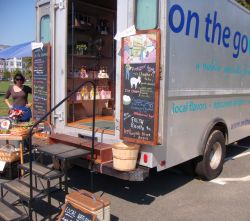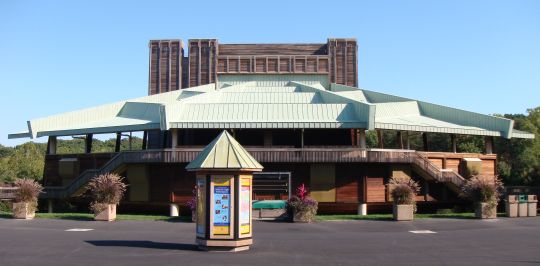
This is a guest post from my travel partner, Todd Dwyer, head blogger for Dell’s ReGeneration.org.
—–

After our visit to the amazing Philip Merrill Environmental Center in Annapolis, Maryland, Sarah and I hopped in our trusty steed, Cletus the Prius, for a drive to the Wolf Trap Foundation for the Performing Arts in search of the nature of art and the art of nature.
Although the Wolf Trap is located in Vienna, Virginia, our contact, Chris Guerre, requested we meet him at a farmer’s market at Ben Brenman Park in Alexandria. Apparently, Chris is a very busy guy. In addition to his duties at Wolf Trap, he and a few of his friends have taken on a weekend gig selling local and gourmet foods from a van.
 Sarah and I have noticed these farmers markets popping up all over the country as we travel from coast to coast, and in addition to America’s newfound concern over the quality of what we eat, I think it is also indicative of a growing environmental movement. Farmers markets like these reduce the food miles it takes for food to travel from the dirt to the dinner plate, and this means much less energy expended. It also spoke volumes about the Wolf Trap Center that its employees would spend their precious weekend time on such a worthwhile pursuit.
Sarah and I have noticed these farmers markets popping up all over the country as we travel from coast to coast, and in addition to America’s newfound concern over the quality of what we eat, I think it is also indicative of a growing environmental movement. Farmers markets like these reduce the food miles it takes for food to travel from the dirt to the dinner plate, and this means much less energy expended. It also spoke volumes about the Wolf Trap Center that its employees would spend their precious weekend time on such a worthwhile pursuit.
After he finished closing up at the farmers market, Chris led us through the infuriating maddening completely nonsensical winding roads of Washington D.C. to Vienna, where Wolf Trap National Park and the Wolf Trap Foundation are located amidst a dense community of oak, poplar, and fragrant pine trees.
The park and Foundation rests on land once owned by connected socialite and philanthropist Catherine Filene Shouse. When she was asked to donate her land to the government to make way for the Dulles Greenway, Shouse agreed, but only if a portion of the land was set aside to become America’s first (and still only) national park devoted to supporting the performing arts. The area remains a sea of green in an otherwise highly developed area — Shouse’s gift to the American people.
Wolf Trap’s 160 or so acres of land is home to several diverse venues, all works of art in their own right, for a variety of shows ranging from popular music to opera to dance performances. One of those venues, called the Barns, is made from two fully restored 18th century barns that reminded Shouse herself of barns once danced and played in as a child. Also at the park is a towering 13-story venue and a children’s theater nestled in the Virginia woods.
With this impressive backdrop, Sarah asked Chris about the relationship between nature and art and about Wolf Trap’s commitment to the environment.
The 7,000-seat Filene Center:

